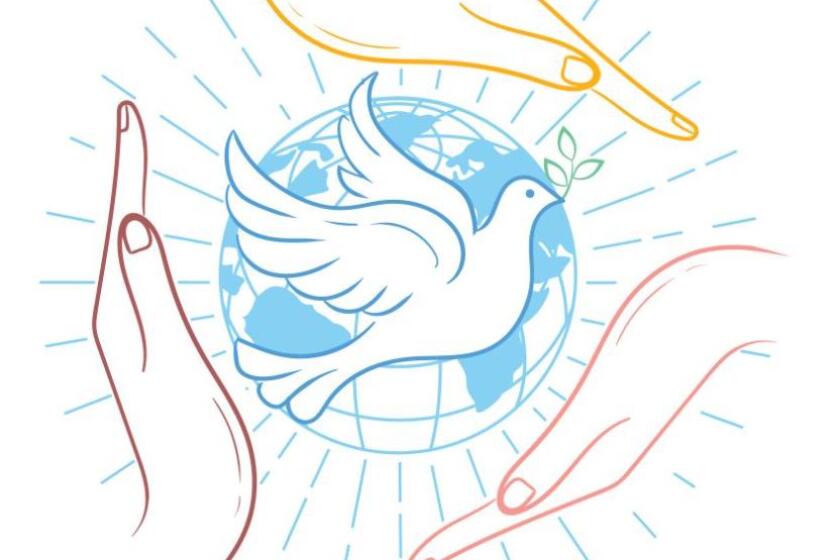Opinion: Here’s what you need to know about the flu, COVID-19 and RSV ‘tripledemic’

Treatments for the flu, COVID-19 and RSV are effective and improving.
Nguyen, M.D., M.H.S., is a board-certified geriatric and internal medicine doctor and Clinical Services Chief of Geriatric Medicine at UC San Diego Health. He lives in San Diego.
There is worry in the air. And viruses.
It is flu season. Cases of COVID-19 are rising — again. A childhood illness called respiratory syncytial virus or RSV is afflicting persons of all ages.
With flu and RSV (respiratory syncytial virus) at unusually high levels and a surge in COVID-19 cases expected soon, the health care system is being tested.
We are in the midst of what has been dubbed a “tripledemic,” one that poses particular risk to older adults, persons age 65 and older, a demographic that increases by 10,000 every day.
Growing older brings many benefits: experience, wisdom, a deeper richness of life. Protection against disease isn’t one of them. Older age is a risk factor.
Different viruses cause the flu, COVID-19 and RSV, but they share similarities. They are contagious. They are transmitted primarily by airborne particles. They have common symptoms: fever, cough, fatigue, headache among them. And for older adults, they are more likely to cause severe illness, hospitalization and death. Numbers tell the story.
Influenza: The Centers for Disease Control and Prevention (CDC) estimates seasonal influenza results in 140,000 and 710,000 hospitalizations annually, with approximately 53,000 deaths. Seventy to 90 percent of these deaths occur in persons age 65 and older.
It’s hard to pinpoint exactly how many people die from seasonal flu because many die from flu-related complications, such as exacerbation of an existing chronic disease, like congestive heart failure, or a secondary bacterial co-infection resulting in fatal pneumonia. Eight in 10 older adults have at least one chronic condition; 1 in 2 have multiple chronic conditions. Underlying medical conditions augment risk and complicate outcomes.
COVID-19: These cases are again rising in many places, including San Diego County, which likely means corresponding increases in hospitalizations and deaths. Older adults have always been at greater risk of severe disease, hospitalization and death from COVID-19. It is their particular plague.
Of the roughly 1.1 million Americans who have died from COVID-19 during the pandemic, 790,000 have been people ages 65 and older. People 65 and older account for 16 percent of the total U.S. population but nearly three-quarters of all COVID deaths to date. More than 300 people are still dying each day on average from COVID-19, most of them 65 or older.
Respiratory syncytial virus: RSV is not a new disease. It was discovered in 1956 and has long been recognized among the most common causes of childhood illness, usually producing mild, cold-like symptoms. But RSV can be deadly, and it can infect people of all ages. Each year, 58,000 to 80,000 children under the age of 5 are hospitalized in the United States due to RSV; 100 to 300 die. Each year, 60,000 to 120,000 older adults are hospitalized with RSV; 6,000 to 10,000 die.
Becoming older boosts the likelihood of underlying medical conditions and, conversely, less robust immune system to fend off infections before serious symptoms appear. Fortunately, there are resources and remedies, actions one can and should take to reduce the risk of severe consequences from the flu, COVID-19 and RSV.
First, get vaccinated or, in the case of COVID-19, get boosted when appropriate.
Flu vaccine efficacy fluctuates with different seasonal strains, but it still measurably reduces the risk of severe disease or death. On average, according to the CDC, a flu shot reduces the risk of flu illness between 40 percent and 60 percent.
COVID-19 vaccines, primarily those based on mRNA technology (Moderna and Pfizer), have proven both safe and effective, especially if the primary vaccination series is followed up with timely boosters. A 2021 CDC report found that among adults ages 65 to 74, the mRNA vaccines were 96 percent effective at preventing hospitalization and 91 percent or more effective for people 75 and older.
There is no vaccine for RSV, but there might be soon. Pfizer recently announced encouraging results from a phase III clinical trial involving pregnant women and their newborns. Clinical trials of similar RSV vaccines for older adults are ongoing; results are pending.
Treatments for the flu, COVID-19 and RSV are effective and improving.
Aside from symptomatic and supportive care — such as rest, hydration and medications for fever and aches — antivirals like Tamiflu, Relenza, Rapivab and Xofluza can, if taken within 48 hours of symptom onset, reduce severity and shorten a bout of the flu.
New COVID-19 treatments are emerging and being refined. Antivirals like Paxlovid and Veklury have been shown to reduce the chances of hospitalization or death if taken shortly after symptoms appear. Monoclonal antibodies offer promise too.
There are no specific remedies for RSV. Treatment focuses on relieving symptoms, much like those of the flu, and monitoring for more severe complications.
The COVID pandemic has taught us many painful lessons, but it is knowledge we can use now. No single test exists to differentiate between the flu, COVID-19 and RSV, which means vigilance and quick action are critical.
If you feel sick, see your doctor. If you don’t feel sick, see a doctor anyway (or any pharmacy or health care provider) to get up to date on vaccinations. Remember that social distancing, masking and good personal hygiene are simple but effective ways to avoid infection.
An ounce of prevention is still worth a pound of cure. Times three.
Get Weekend Opinion on Sundays and Reader Opinion on Mondays
Editorials, commentary and more delivered Sunday morning, and Reader Reaction on Mondays.
You may occasionally receive promotional content from the San Diego Union-Tribune.





